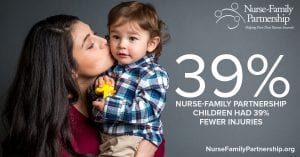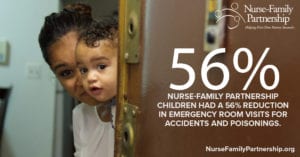Nurse-Family Partnership is often cited as THE intervention for preventing child abuse and neglect.
The evidentiary standards for the Nurse-Family Partnership program are among the strongest available for preventive interventions offered for public investment. In fact, in medical and scientific journals, Nurse-Family Partnership is most often cited as the most effective intervention to prevent child abuse and neglect, which contributes to childhood injury. Injury, in turn, is the leading cause of death for children from age one to early adulthood.

The results from the Memphis trial document the young lives saved through Nurse-Family Partnership. While most children survive abuse and neglect, the legacy is often devastating, frequently leading to lifelong struggles. For these reasons, many in the law enforcement community across the nation praise Nurse-Family Partnership as a key prevention program.
Among the reduction in child abuse and neglect and injury outcomes that have been observed in at least two of the three randomized, controlled trials of the program are:
- Reductions in child abuse and neglect
- Reduction in health-care encounters for injuries
In the Elmira trial (where families have been followed the longest), there were long-term effects on reducing state-verified rates of child abuse and neglect (a 48% reduction1). Also in the Elmira trial, there was a 56% relative reduction in emergency department encounters for injuries and ingestions during the children’s second year of life.2 In the Memphis trial, there was a 28% relative reduction in all types of health care encounters for injuries and ingestions, and a 79% relative reduction in the number of days that children were hospitalized with injuries and ingestions during children’s first two years.3

In both of these trials, the impact of the program on injuries was more pronounced among children born to mothers with fewer psychological resources to manage well the care of their children while living in concentrated social disadvantage.
In addition, in the Memphis trial, children in the control group, as a trend, were 4.5 times more likely to die in the first nine years of life as were children who had been visited by nurses, a difference in mortality accounted for by deaths due to prematurity, Sudden Infant Death Syndrome, and injuries.4
While the randomized trials show evidence of beneficial effects for child abuse and neglect, this area of research is still emerging for the broader replication of Nurse-Family Partnership.
1. Olds D, Eckenrode J, Henderson C, Kitzman H, Powers, J, Cole R, Sidora K, Morris P, Pettitt L, Luckey D. Long-term effects of home visitation on maternal life course and child abuse and neglect: a 15-year follow-up of a randomized trial. JAMA 1997: 278(8):637-643.
2. Olds DL, Henderson CR Jr., Chamberlin R, Tatelbaum R. Preventing child abuse and neglect: a randomized trial of nurse home visitation. Pediatrics 1986: 78(1):65-78.
3. Kitzman H, Olds DL, Henderson CR Jr., Hanks C, Cole R, Tatelbaum R, McConnochie KM, Sidora K, Luckey DW, Shaver D, Engelhardt K, James D, Barnard K. Effect of prenatal and infancy home visitation by nurses on pregnancy outcomes, childhood injuries, and repeated childbearing: a randomized controlled trial. JAMA 1997; 278(8):644-652.
4. Olds DL, Kitzman H, Hanks C, Cole R, Anson E, Sidora-Arcoleo K, Luckey DW, Henderson CR Jr., Holmberg J, Tutt RA, Stevenson AJ, Bondy J. Effects of nurse home visiting on maternal and child functioning: age-9 follow-up of a randomized trial. Pediatrics 2007: 120(4):e832-845.

